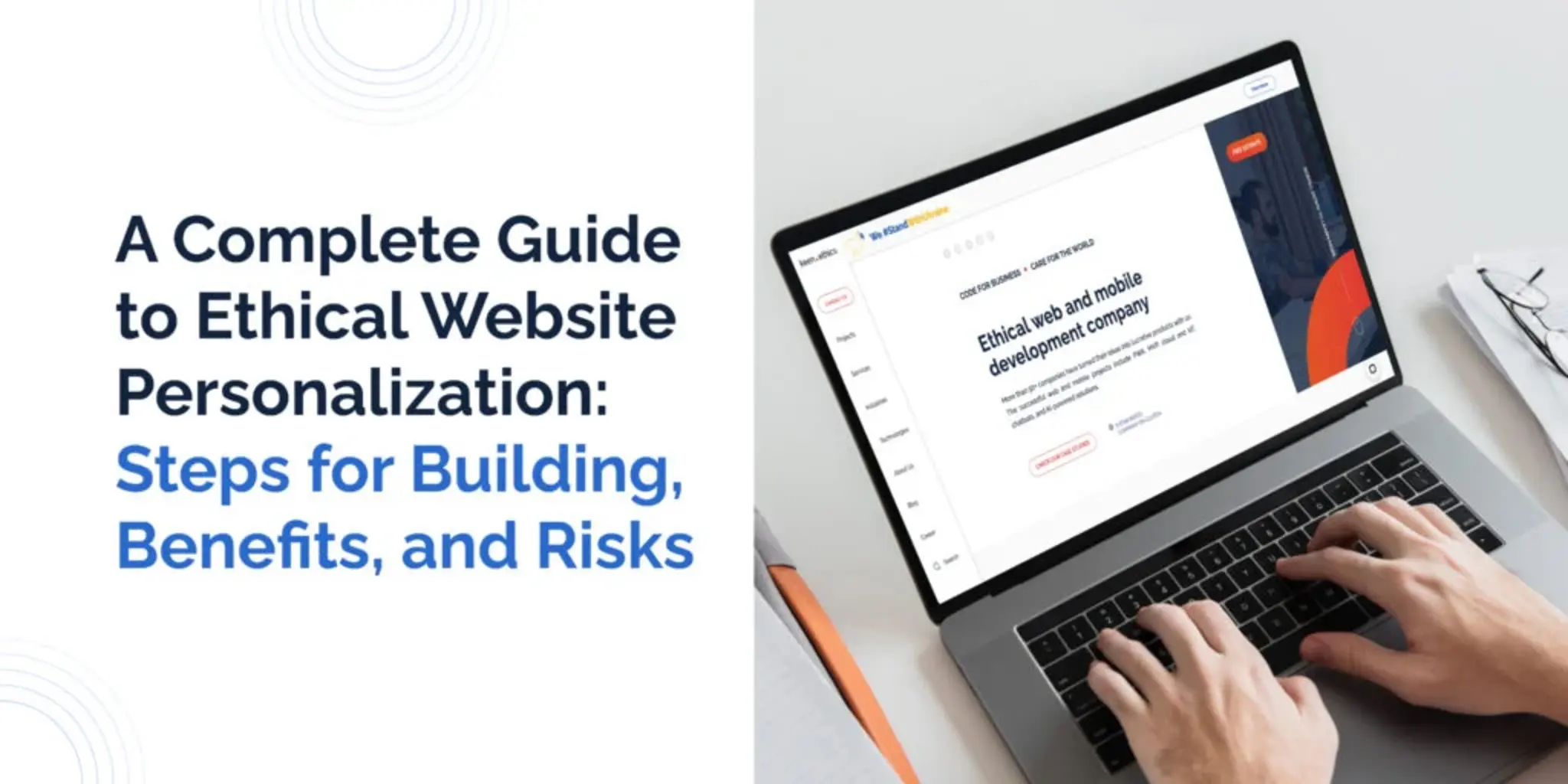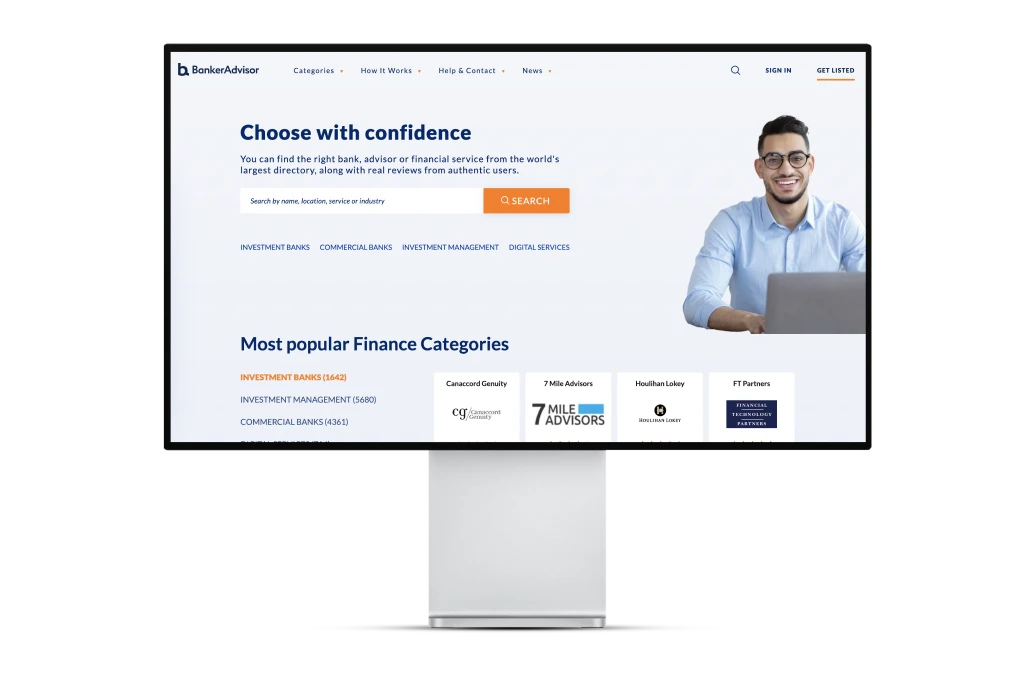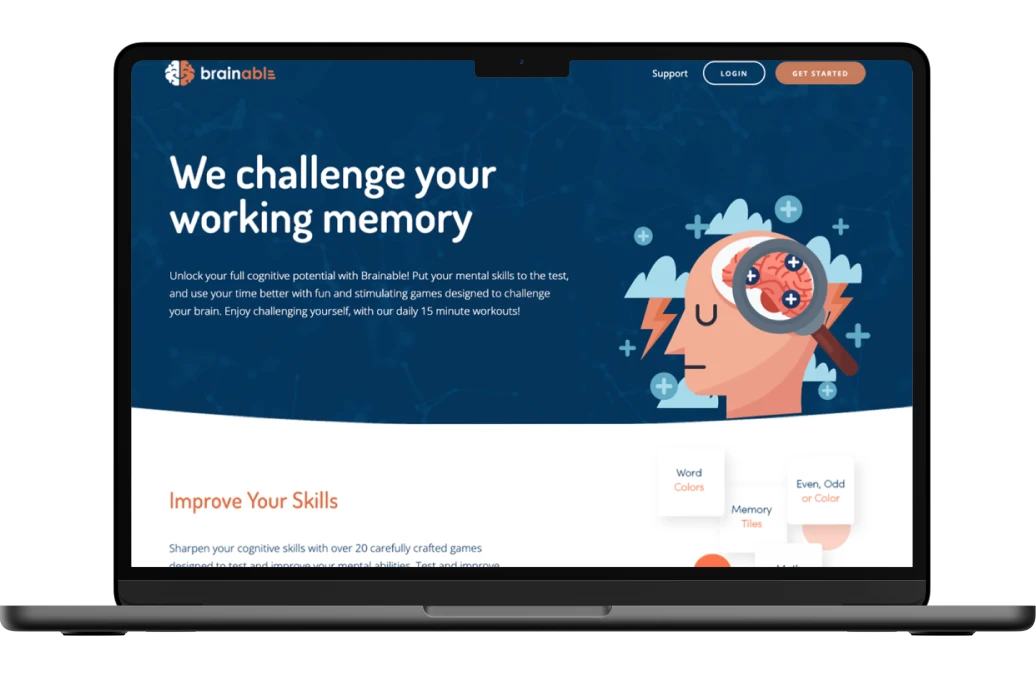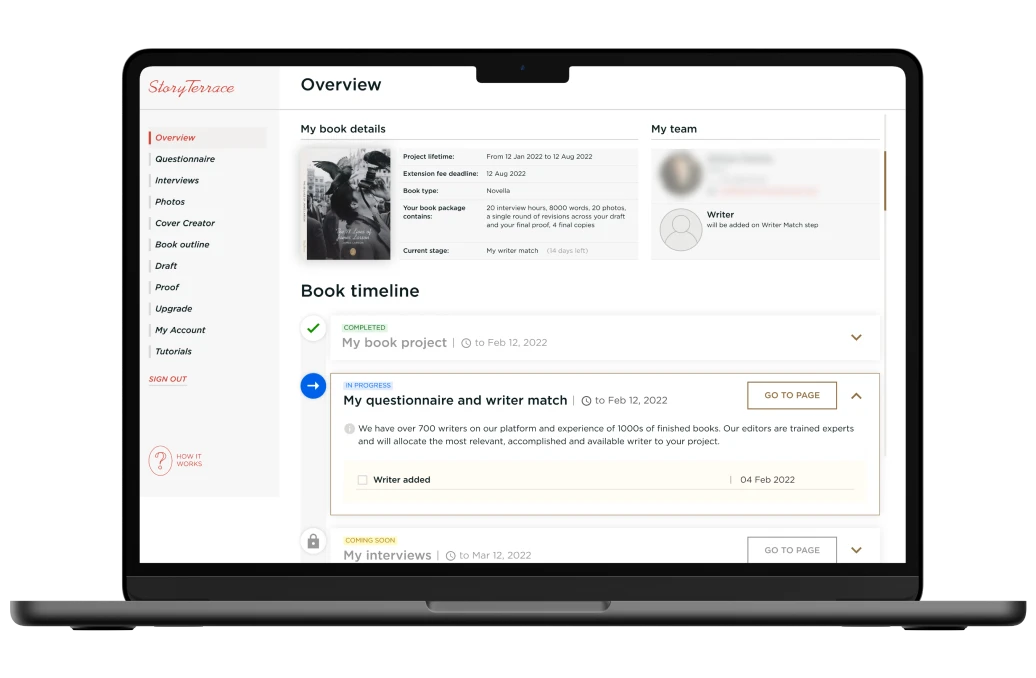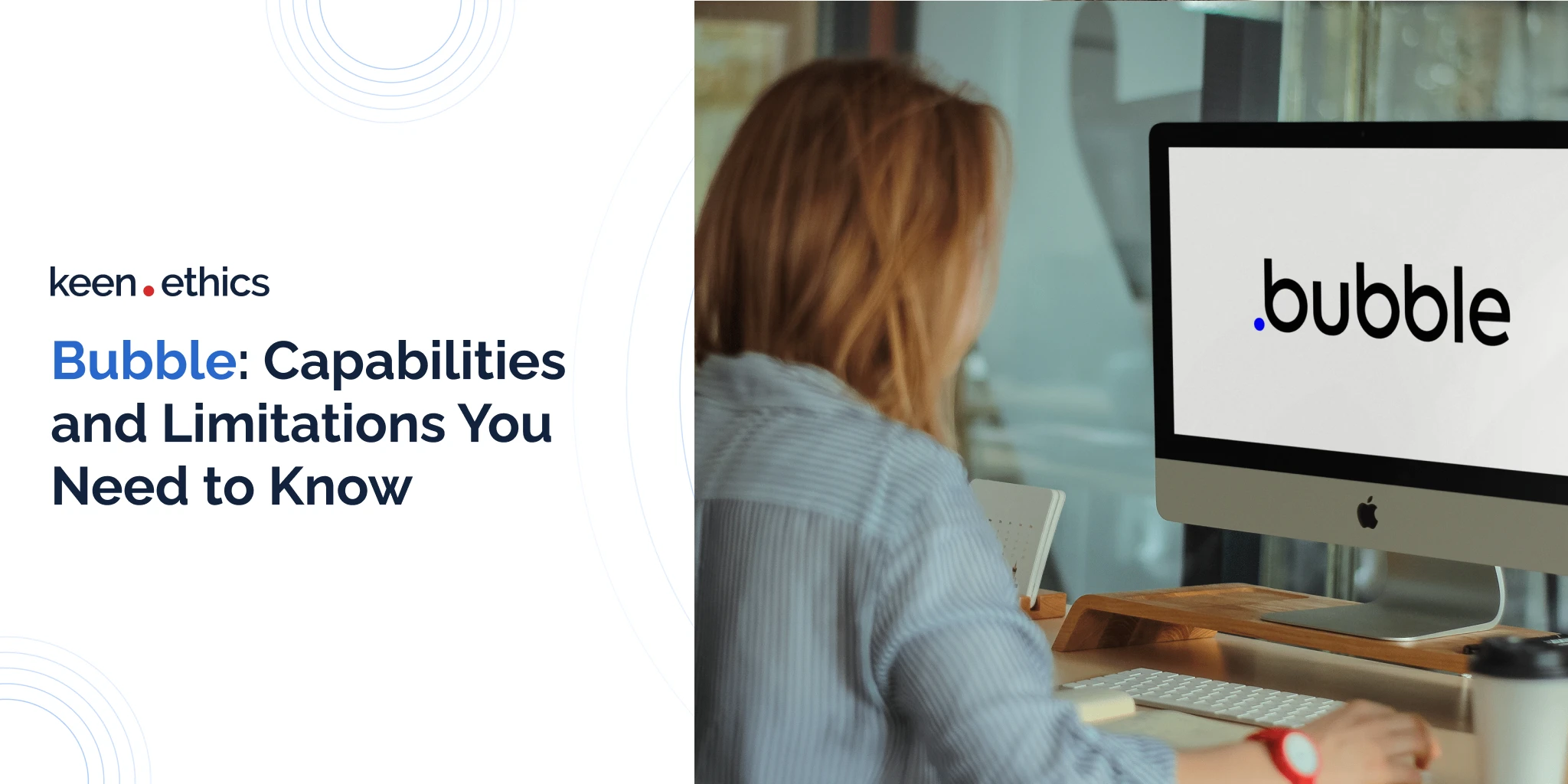It’s one thing when brands dictate to people what is fashionable and what they should buy, thereby artificially imposing the brand’s needs. Another thing is trying to listen to the customers, responding to their real needs. The second case is website personalization, a topic our guide describes.
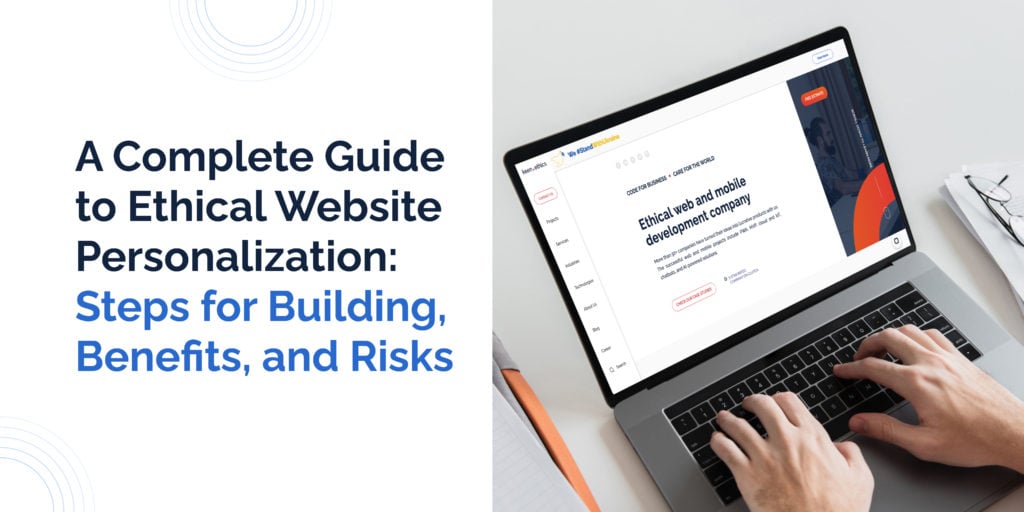
In today’s digitized landscape, systems generate more data than most organizations can handle. Some estimate that more than 2.5 quintillion bytes of data are created daily.
Now, if you collect this data, you can put it to good use. You can learn about your users’ needs and desires and serve them with customized content. Fortunately or unfortunately—depending on your moral perspective—there are rules to using user data.
This guide weighs the benefits of customer personalization against the risky usage of personalized marketing.
What is Customer Personalization?
Is the customer personalization “a good-to-have” feature or customers’ expectations? We have a response.
Personalizing web experiences is a well-established marketing process providing a unique service through messages, offers, and tailored pricing to the customers according to their preferences. Personalization aims to deliver relevant customer experience to get marketers and business owners main profits like customer retention, better loyalty, and product revenue. An engagement email or a broad range of recommendations isn’t enough. It’s about setting the whole customer journey. This is key to attracting your audience and keeping them from leaving your website.
How does a good personalization work? To provide user personalization, organizations collect customer data from various sources. It includes data from customer profiles, behavioral data from brand interactions, and data from devices that customers use to view your website. In brief, the company gets the customer’s information through data analytics. Then it creates a meaningful experience at every stage of the customer’s journey, from buying history to a one-on-one consultation.
However, customer personalization doesn’t always work well. There is a fine line between customization and intrusive invasion of privacy. So, respect for the customers and a robust approach are a must for success in digital marketing.
What is Website Personalization?
Every visitor is an individual. When considering website personalization, you should understand that two web visitors are different; accordingly, their web journeys should differ and respond to their interests.
Businesses can get a healthy influx of conversions as the internet becomes more interactive and user-oriented. The task of the companies is to set the best-performing personalizing web experiences and serve them across traffic. Today, resonating with visitors is more than creating a lovely website or sharing content on social media. Brands wishing to influence visitors’ decision-making must consider an effective web personalization strategy.
The Benefits of Website Personalization
Personalization for a website can be an amazing business tool when used carefully. It enables you to reflect information about a customer in brand interactions and build relationships that are difficult to achieve with generic interactions. These strong relationships can provide several benefits for customers and companies.
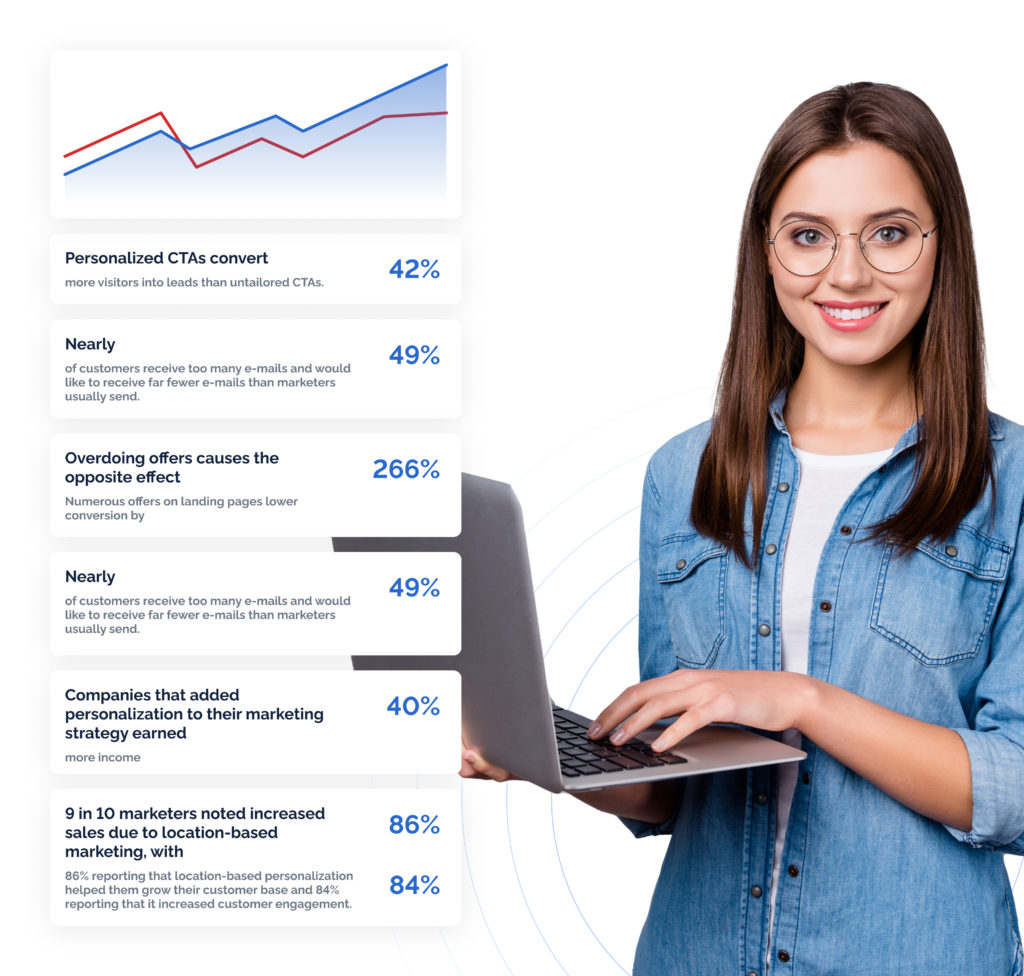
The list of pros can be vast, but we’ll present the key ones:
#1 Improved lead generation through converting CTAs
Today, the internet is overwhelmed with ads, and visitors may feel skeptical about personalization. A good call-to-action isn’t created on its own. Behind a working CTA, it’s essential to count the customers’ behavior and preferences in the buyer’s journey. CTA has different goals. It can drive the customer to book a consultation, learn more about the company’s service, take a survey, or watch a demo. By creating a relevant CTA responding to customers’ wishes, you, as a business owner, can speed up the purchase process. Creating a personalized CTA has many pros. If, for instance, a visitor is already your regular customer and knows about your products, offering them to sign up for mailing is useless and strange. Instead, you can provide a new product and encourage them to watch the client’s feedback. The idea of CTA greatly depends on the product your company offers. Stats say personalized CTAs convert 42% more visitors into leads than untailored CTAs. But don’t overdo offers to avoid getting the opposite effect. Numerous offers on landing pages lower conversion by 266%.
#2 Relevant product offers
Personalization can help you build and maintain customer engagement, often leading to purchases. It enables you to reach out to your customers with content and offer something they will likely appreciate and act on. For example, you can propose meaningful recommendations for product upgrades or add-on purchases.
Have you, as a customer, ever experienced the irritating feeling when somewhat sites wanted you to buy something you weren’t interested in? It’s an annoying feeling, we agree. For this reason, when implementing website personalization, think about using the customer’s data properly. To get the benefits from web content personalization and provide the benefits for the customers, you should collect and sort customers’ data based on their purchase history to ensure your offers are topical and fresh for them. Make your site more tech-savvy, and results won’t be slow to wait.
#3 Stronger brand image
Your brand’s image is key in raising customers’ confidence in your product. Aiming to be the biggest retailer is usually ineffective, but excelling in a particular market niche is worthwhile.
Personalization ensures that your message to potential and current customers is consistent with this strategy. It can also help you differentiate yourself from competitors. Carefully targeting your customers’ interests and connecting your brand with their lives directly enables you to stand out. Applying personalization strategies can also help create a reputation for customer service and implement strategies other brands may lack. For example, when customers’ preferences are applied to communications, they’re more likely to feel respected and valued.
#4 Greater customer loyalty
Customer loyalty can make or break a brand. Loyal customers make consistent purchases, refer others, and increasingly provide free advertising through social media. This makes creating and maintaining loyalty a key consideration for any brand.
You need to build strong relationships with customers and keep them engaged to increase loyalty. One way of doing this is to ensure that every communication with a customer is relevant and beneficial. For example, after a customer purchases a new product from you, you can follow up with some useful tips. This custom content type shows that you invest in the customer and want them to benefit most from your product.
#5 Better brand perception
The study shows that not all customers like e-mail notifications. Nearly 49% of customers receive too many e-mails and would like to receive far fewer e-mails than marketers usually send. Moreover, if your customers work with mail daily, your messages will end up in spam automatically or due to a lack of customers time. The question is what stands behind such a verdict of these customers. 49% of them is a large number, so even if you think your product is too valuable for your client, before sending out the newsletter, assess if all customers would like this personalization. One of the solutions is to collect your customer base, sort them according to their search, choice, and purchase history, and through testing, you’ll determine which of the customers respond to your e-mails and if there is any conversion. You shouldn’t jump to conclusions right away. But by taking an estimate over several months, you’ll get a clear insight into if your personalization through mailing works.
The Risks of Website Personalization
Website content personalization can be a great tool for building customer relationships but can also be risky or downright harmful. It requires collecting a significant amount of customer data, some of which is sensitive. Customers often provide this data to brands when creating buyer profiles or taking quizzes for product recommendations. However, sometimes customers are unaware of the depth of information they share and how it’s used. If this information is used too much for marketing goals, they may feel a brand is abusing their trust.
The above benefits resonate with the possible risks of overusing website personalization. But let’s look at the personalization risks you should count as a business owner.
Data liability
One of the greatest risks of personalization stems from the collected data. When you collect and store personal information about customers, the critical point is to ensure that this information remains private and is only used with customer permission.
You can be legally liable if you collect information without permission or sell data without notification. You can also lose customer faith and business reputation. This doesn’t mean you should repeatedly ask for permission to collect or use data. It means you must be upfront about data collection and limit access from third parties.
Aggressive or insensitive personalization
While most customers appreciate a curated experience with brands, there are limits to website personalization. If you apply every bit of customer data to your interactions, they can feel more harassed than pleased.
Additionally, if a customer has a single interaction with your brand, they don’t want to be bombarded with recommendations or communications. Effective website personalization should be a friendly recommendation for the customers. When personalization acts too far, customers are likely to abandon a brand, and some may even complain on social media, hurting your brand image.
Customer data privacy and security
The security of customer data shouldn’t be perceived as a risk but as an obligation for everyone responsible for collecting customer data. On the one hand, this aspect should neither be taken as easy nor something extra challenging. When considering needed regulations and factors from a legal and ethical standpoint beforehand, no risk should occur. On the other hand, if data privacy and security weren’t a real risk, such laws as GDPR (General Data Protection Regulation) and CCPA (California Consumer Privacy Act) won’t go into effect. Customers desire more transparency in how their data is collected and handled. Well, what are your next steps?
To protect customer data, the company should follow the next recommendations:
- limit the access to customer data for the third-parties;
- enhance cybersecurity and manage access through password management tools;
- store data in a centralized location;
- adhere to minimum security standards the company should consider;
- consider robust data management strategies and policies;
- use secure software for encrypting and updating all data to prevent hacking attempts;
- stay up-to-date with any customer data regulations and improve your data safety standards.
Overpersonalization
The problem with overpersonalization is the relevance of search results. There exist two concepts in search results – precision and recall, where precision is the actual relevance of search results and recall is the percentage of potentially relevant results for the users. You may fail if you prioritize precision over recall and show the customer only the relevant results. Imagine your customer has two main interests, like tablets and laptops. The user wants to see relevant posts about tablets and laptops, but the platform doesn’t indicate that the user likes laptops. As a result, they see only posts about tablets. Moreover, this user may think a Mac laptop may be more beneficial for their goals. Still, the offer about “this potential interest” will never be shown to the user till marketers prioritize recall in personalized content.
The dark side of personalization is that you provide users with the same type of content for a long period. In turn, you don’t expand customers’ interests and have fewer opportunities to learn new things about customers. Your customers aren’t one-dimensional but complex, multifaceted characters. Remember that when considering their preferences in the product chain.
Increased cost
More delicate implementations always need more resources and costs. Personalization for a website often involves advanced technology, including AI/ML, more labor, and talents to offer you the appropriate strategies. These are only superficial factors. Other factors influencing the price are the level of required personalization, the website size, the complexity of chosen technology, and available resources. Recruited specialists for personalization is a separate issue. Aspects such as the level of expertise, years of practical experience, and team location play a role here. Before implementing personalization, you should carefully evaluate costs and benefits. A little spoiler – the customer satisfaction and business revenues pay off. McKinsey’s report says that companies that added personalization to their marketing strategy earned 40% more income.
Website Personalization Examples
In digital experiences, website personalization has emerged as a powerful tool for businesses to connect with their users on a deeper level. Let’s explore some proven personalization website examples, showcasing how companies can create engaging interactions with web visitors.
Personalized recommendations
Personalization helps to display product recommendations based on a user’s browsing or purchase history, allowing them to discover relevant items tailored to their preferences.
Customized user interfaces
One of the best interactions with the users is allowing them to personalize the website’s layout, design, or settings to suit their preferences and improve usability.
Tailored offers and promotions
You can get higher conversion rates by providing exclusive discounts, offers, or promotions based on a user’s interests and previous purchases.
Targeted notifications
Depending on a customer’s journey stage, you can send appropriate personalized messages or notifications.
Location-based personalization
9 in 10 marketers noted increased sales due to location-based marketing, with 86% reporting that location-based personalization helped them grow their customer base and 84% reporting that it increased customer engagement.
Finally, you can combine any of these website personalization examples, and no matter what you choose, remember, you shouldn’t orient on top competitors. Your marketing campaign should be as unique as your customers. So, try to provide tailored content to attract your target audience. What is better than knowing your audience values your brand and is ready to recommend it to their friends?
Eight Steps to Build a Website Personalization Strategy
Try not to miss a chance to convert your site’s visitors into potential customers. The popular Pareto principle is practical in any business offering to optimize resources relevantly to reach the profitability of a business. It states that 80% of problems result from 20% causes.
So, let’s view the steps to build the right website personalization strategy for your business.
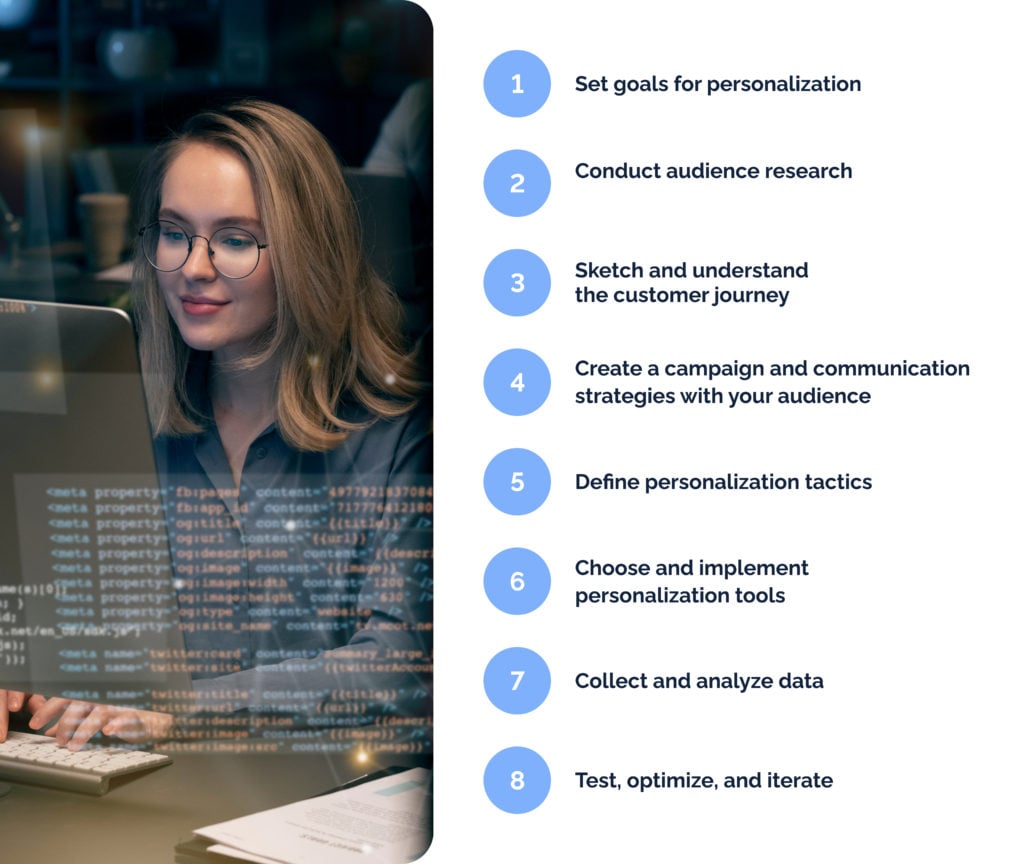
Step 1: Set goals for personalization
The first step is to define the goals you want to achieve with personalization. Some goals may already be obvious, so try to list even the obvious ones. Sometimes, elementary things may be a real cause driving your business. Learn more about your customers? Increase retention? Show the brand image? Nothing is less important. Assess revenues? By setting the proper goals, you’ll create a more targeted strategy.
Step 2: Conduct audience research
Successful results come when you define the target audience. At this stage, try to research as many aspects as possible, including demographics, behaviors, preferences, problems, and motives of the customers. The tools like Google Analytics, customer surveys, and user feedback will help you collect insights about your website visitors.
Step 3: Sketch and understand the customer journey
Getting a real lead and conversion takes time. To move a user from a usual web visitor to a potential customer, you need to specify which stages in the customer journey you can improve via personalization. All this should be accomplished through the eyes of your consumer. Identify the various touchpoints a user may have with your website. From the first visit to conversion and beyond, map out the stages of the customer journey. Determine where personalization can be applied to create a more tailored experience at each step.
Step 4: Create a campaign and communication strategies with your audience
Your audience involves individual characters, and it’s okay. Your perception concerning your product may be far different from theirs. Divide your audience into different segments based on shared characteristics or behaviors. This segmentation will allow you to personalize content and experiences for each group more effectively. Consider location, age, interests, purchase history, and browsing behavior. Note that quantity isn’t quality. If you have a wide audience, choose the strongest customer segment first and document the messages primarily for their needs. Content diagnostic tools will allow you to define the most appreciated content by your audience. You can document at which stage of the customer journey the user gets interested in and which content is relevant. This way, you can easily define gaps in creating brand tone.
Step 5: Define personalization tactics
Personalizing many things is tempting. However, it’s better to start small and test iteratively to figure out the entire strategy. But setting the whole website personalization strategy is almost one of the final stages, so don’t rush. Determine the specific ways in which you can personalize your website for each audience segment. This can include dynamically changing content, recommending relevant products, displaying personalized messages, or customizing the user interface based on preferences.
Step 6: Choose and implement personalization tools
Even the most powerful marketing tools don’t mean they’re targeted ones in your case. You need to choose and implement the appropriate personalization tools and technologies to execute website personalization best practices for your campaign. These can include content management systems (CMS) with personalization capabilities, customer data platforms (CDP), or third-party personalization tools. Choosing the personalization tool without understanding its functionality isn’t the best option for executing any step in your plan.
Step 7: Collect and analyze data
At this stage, you have to set up mechanisms to collect data on user behavior and interactions with your website. You can leverage tools like cookies, user accounts, and tracking pixels to analyze this data and gain insights into user preferences and patterns.
Step 8: Test, optimize, and iterate
Finally, A/B testing and control of a user experience will help you analyze if your personalization strategy works and achieves desired objectives. Have you found a working campaign? Continue to optimize it. Continuously test and optimize your personalization efforts. Besides A/B testing, you can use heatmaps and user feedback to assess the impact of personalization on user experience and your defined goals. Iterate and refine your strategy based on the gained insights. Remember, personalization is an ongoing process. You need to regularly review and update your strategy to ensure it remains aligned with your business objectives and the evolving needs of your audience.
KeenEthics Experience in Website Personalization
We’re a trusted web development company specializing in crafting personalized website apps and platforms, helping our customers leave a lasting impact on web visitors. With a team of skilled developers and a deep understanding of user behavior, we have helped numerous businesses achieve unparalleled success through website personalization. By the way, you can see our portfolio.
When you start a partnership with Keenethics, we begin by immersing ourselves in your brand, understanding your unique goals, and digging into your audience’s main working segments. Through detailed audience research, we get valuable insights that form the foundation of our website personalization strategy. Our professional developers then transform these insights into actionable tactics. We seamlessly integrate personalization features into our clients’ websites by leveraging cutting-edge technologies and industry best practices. If it’s dynamically changing content, recommendation of the relevant products, or tailored user interfaces, we craft experiences that engage users on a deeper level, drive conversions and foster brand loyalty. At Keenethics, we believe that web content personalization isn’t a one-time project but an ongoing process.
How to Balance Personalization and Customer Rights
38% of businesses struggle to balance personalization and data privacy. Using web personalization and customer data ethically can be a challenge. It may not be clear when ethical lines have been crossed. Or, customers may have different ideas from your own about what ethical use entails. To ensure that you act with due diligence to your customers and data privacy laws, keep the following considerations in mind:
#1 Maintain data compliance
Be always up-to-date with data compliance guidelines and their practical application. For example, GDPR or the California Consumer Privacy Act. These regulations vary by region, so you must be mindful of who you collect data from, where it’s stored, and where it’s used.
#2 Establish data transparency
Be transparent with your customers about how and why data is collected. This means you should notify users before collecting data and allow them to reject providing data. Transparency should also include informing customers about how you’re protecting their data and telling them if data is exposed.
#3 Practice what you preach
Ensure you use data according to your claims. If you say you apply data in your customer’s best interest but turn around and sell that data, you’ll lose customer trust.
Conclusion
In conclusion, personalization for a website is a multifaceted topic that may be discussed for hours from the legal and ethical side. While it brings profits, you shouldn’t forget about risks. Always try to assess your product through the customers’ eyes without sacrificing data privacy and security.
We remind the following:
- improve cybersecurity and manage access to customer data;
- store data in a centralized location;
- stick to minimum security standards the company should consider;
- define and document robust data management strategies and policies;
- use secure software for encrypting and updating all data to prevent hacking attempts;
- stay up-to-date with any customer data regulations and improve your data safety standards.
Good luck! A good foundation of web content personalization implies the best results.
FAQs About Personalization For Website
What is website personalization?
Website personalization is tailoring a website’s content to respond to web visitors’ preferences and needs by delivering targeted messages and offers. Web personalization helps us to achieve a deeper level of engagement and better retention of each visitor. It’s the process encompassing diverse strategies for relevant displaying content based on user behavior, demographics, and previous interactions.
What are the pros of website personalization?
Website personalization offers the following benefits for businesses:
#1 More meaningful and tailored user experience: by catering to the users’ needs and interests, businesses can create a more enjoyable user experience, increasing satisfaction and loyalty.
#2 Better conversion: by presenting users with tailored recommendations and messages, businesses can get users to take desired actions, such as purchase, filling out a form, or subscription to a service.
#3 Customer retention: businesses can increase user engagement, encourage repeat visits, and foster long-term customer relationships, thus improving customer retention rates.
#4 Positive perception of the brand: users like to feel valuable, so by implementing personalization, the company can improve its image in the customer’s eyes.
#5 Targeted communication: by sorting users into segments, you can maximize the effectiveness of the marketing campaigns.
#6 Data-driven insights: through data analysis, businesses can gain valuable insights into user behaviors to refine marketing strategies, optimize user experiences, and identify new opportunities.
#7 Competitive advantage: you can differentiate your business from competitors by attracting customers who value personalized experiences.
Why is website personalization critical?
Website content personalization is critical for businesses due to following reasons:
- driving user engagement;
- boosting conversions;
- enhancing customer satisfaction and loyalty;
- providing targeted marketing;
- gaining data-driven insights;
- staying competitive;
- meeting users’ evolving expectations in a personalized digital market.
How does website personalization work?
Website personalization uses data and technology to tailor a website’s content, design, and user experience to individual users or segments. It involves collecting and analyzing user data to understand preferences, behaviors, and demographics. Then, this data is used to dynamically adjust website elements such as content, recommendations, user interfaces, and messaging to create a relevant experience for each user.
Our professional BAs and PMs will gladly help you implement the idea!

